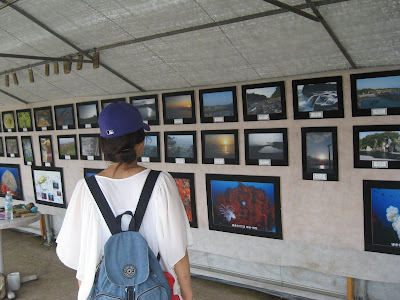 A photo display of soft coral reefs and other sea life along the coast in the Gangjeong village
A photo display of soft coral reefs and other sea life along the coast in the Gangjeong village
In July (during the slow farming time) the villagers will hold their third pilgrimage around the island to bring the issue to the public's attention. The walk will last one week during the hot season. Many of the villagers are elderly but they will make the pilgrimage through all the other villages on the island because they feel they must continue to do everything possible to try to block the building of the base.
- Corazon Fabros reported that the U.S. still refuses to take responsibility for the toxic pollution long after its Navy base was closed in the Philippines. "We have to match our enemies strength with our unity and solidarity," she said.
- Shinako Oyakawa (University student from Okinawa) shared that 20% of their island has U.S. military bases since the end of WW II. Now the U.S. is attempting to build another base on environmentally sensitive lands in Henoko, Okinawa. They have learned that the U.S. military created the Henoko base plan all the way back in 1966. 85% of Okinawa citizens want the U.S. bases closed.
- Michael Lujan Bevacqua (College instructor from Guam) said that 30% of Guam has U.S. bases, and the U.S. wants to build two more, also to be located in environmentally sensitive locations on the island. The U.S. military controls the largest water source on the island. The U.S. Navy wants to bring nuclear-powered aircraft carriers to Guam which will kill the coral reefs.
The South Korean government has announced that they intend to begin actual construction of the Navy base in September and expect to be finished in 2014. The South Korean Defense Minister has called the Gangjeong villagers "African natives" in an obvious racist slap at the fact that they are unwilling to be controlled.
The people in Gangjeong are a rare inspiration. They intimately feel their sacred connection to the land, the sea, the rocks, the fish, and the coral. As a village young and old alike are taking collective responsibility to protect it all. It is not a common sight in today's world to see virtually an entire village moving together with such common purpose. It indeed is a pure honor to be able to witness and find even small ways to support such a principled struggle.
My primary lesson from listening to the villagers of Gangjeong, and the other activists from Okinawa, Guam, and the Philippines is that the American people have no clue about the suffering that our military bases around the world are causing the people who have to deal with these outposts of empire. Many U.S. citizens seem to avoid opening their hearts to the enormous harm that is being done in our name with our tax dollars. The environmental degradation that results from these U.S. bases is beyond imagination.
The voices of those opposing U.S. bases must be heard. Each of us should hear their crys for support and we must do more in our own communities to bring these appeals to the public attention. The American people must learn that there is a consequence somewhere in the world when our planes, ships, tanks, and troops are deployed in a particular country. There is an impact on the environment and the human population who live there.
No comments:
Post a Comment